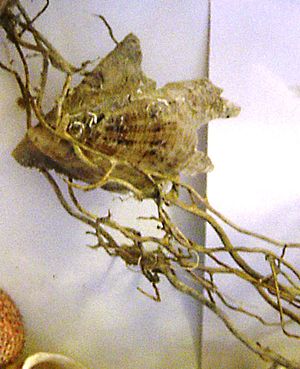Bird clam
| Bird clam | ||||||||||||
|---|---|---|---|---|---|---|---|---|---|---|---|---|

Pteria hirundo |
||||||||||||
| Systematics | ||||||||||||
|
||||||||||||
| Scientific name | ||||||||||||
| Pteria hirundo | ||||||||||||
| ( Linnaeus , 1758) |
The bird clam ( Pteria hirundo ) is a shell - type in the family of pteriidae (Pteriidae) from the order of Pteriida .
features
The somewhat unevenly hinged, fairly flat case is oblique-egg-shaped with a maximum size of 11 centimeters. The right valve is flat to slightly arched, the left valve is more arched. The case is longer than it is high. The greatest height is reached in the rear part of the housing. The vertebra sits near the front end and is curved forward. The long dorsal edge is straight and drawn out into long wing-like appendages ( ears ) at the back and front . The rear process is often several times as long as the front process in adult animals, in juvenile specimens the process is shorter. The rear bay between the ear and the case body is usually deep, in juvenile specimens shallower. The rear end is tightly rounded. The front edge is only moderately rounded and merges into the ventral edge without changing the curvature. Below the front ear of the right valve is an opening for the byssus . The inside edge of the case is smooth.
The cardinal field ( lock ) has a flat triangular ligament pit that takes up about a third of the dorsal field. The lock of the right valve has a small pit below the vertebra into which a small tubercle of the left valve engages.
The yellowish-gray to light gray skin is firm but brittle, the edge is scaly. Often the cases also show dark brown radial bands or wrinkles. The surface of the case has concentric wrinkles and scales. The periostracum is brown to reddish brown, often flaking, and can be extended to hair at the edge of the housing. The inside is iridescent blue and white.
The anterior sphincter is completely reduced. The posterior sphincter is now almost in the center and is fused with the byssus retractor muscle, which can only be seen as a dorsal bulge of the sphincter. The surface line is entire and relatively far from the edge of the case.
Geographical distribution and habitat
The bird clam occurs in the eastern Atlantic from southern England to Angola and in the western Atlantic from Massachusetts to the coast of Brazil. They are also found in the waters around the Azores and the Canary Islands . They live there at depths of around 10 to 290 meters water depth. They are attached to hard ground with byssus threads, but also to fan corals and algae.
Taxonomy
Carl von Linné first described the taxon as Mytilus hirundo in 1758 . It is the type species of the genus Pteria Scopoli, 1777 by monotype. The World Register of Marine Species lists numerous synonyms : Avicula aculeata Risso, 1826, Avicula anglica Brown, 1827, Avicula britannica Leach, 1852, Avicula communis Lamarck, 1801, Avicula falcata Lamarck, 1819, Avicula gruneri Dunker, 1872, Avicula jeffre , 1872 Avicula marmorata Reeve, 1857 Avicula nitida AE Verrill 1881, Avicula plicatula Dunker, 1872, Avicula signata Reeve, 1857 Avicula tarentina Lamarck, 1819 Avicula undata Dunker, 1872, Avicula Verrilli Cossmann, 1912, Avicula versicolor Dunker, 1872 , Avicula vitrea Reeve, 1857, Pinctada apus Röding, 1798 and Pinctada brunnea Röding, 1798.
supporting documents
literature
- Rosina Fechter, Gerhard Falkner: Mollusks. 287 p., Mosaik-Verlag, Munich 1990 (Steinbach's Nature Guide 10), ISBN 3-570-03414-3 (p. 80)
- Rudolf Kilias: Lexicon marine mussels and snails. 2nd edition, 340 p., Verlag Eugen Ulmer, Stuttgart 1997 ISBN 3-8001-7332-8 (p. 262)
- Fritz Nordsieck : The European seashells: From the Arctic Ocean to Cape Verde, the Mediterranean Sea and the like. Black Sea. 256 p., Stuttgart, G. Fischer 1969 (p. 41).
- Guido Poppe and Yoshihiro Goto: European Seashells Volume 2 (Scaphopoda, Bivalvia, Cephalopoda) . 221 pp., Verlag Christa Hemmen, Wiesbaden 1993 (2000 unc. Reprint), ISBN 3925919104 (56)
On-line
Individual evidence
- ^ Carl von Linné: Systema naturae per regna tria naturae, secundum classes, ordines, genera, species, cum characteribus, differentiis, synonymis, locis. Tomus I. Editio decima, reformata. Pp. 1–824, Holmiae / Stockholm, Salvius, 1758. Online at Göttinger Digitization Center (p. 706).
- ↑ World Register of Marine Species: Pteria hirundo (Linnaeus, 1758)